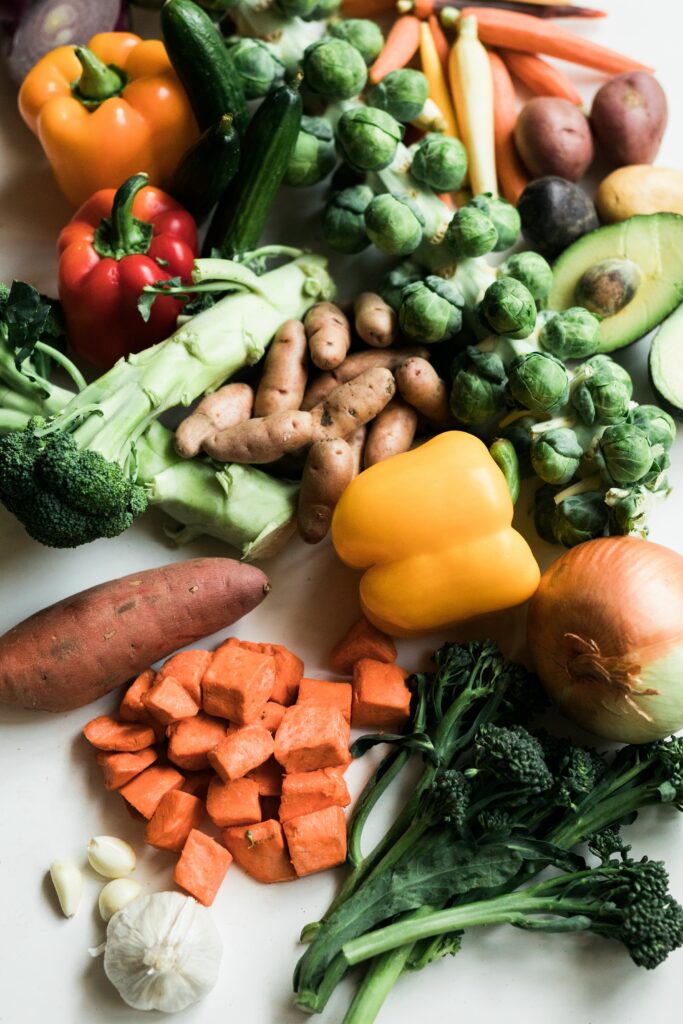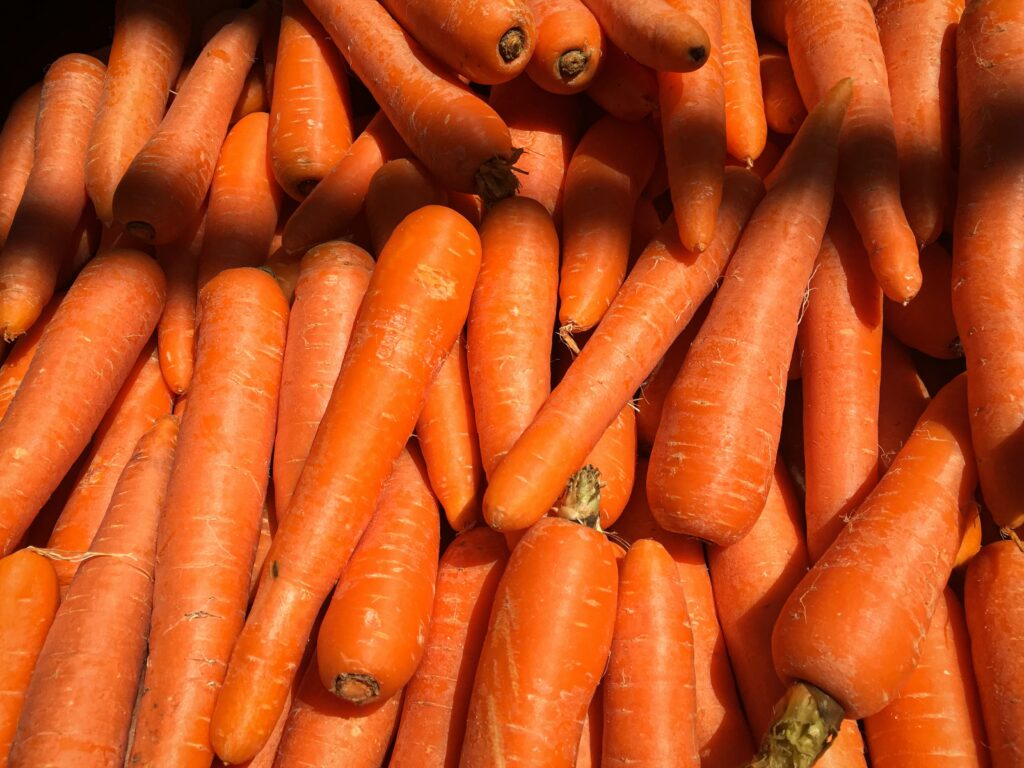One of the most tried-and-true pieces of nutrition advice? Eat your veggies! Vegetables are some of the most nutrient-dense (and economical) foods available. They’re loaded with vitamins, minerals, and fiber. They also provide plant compounds that can help prevent a slew of diseases. Ultimately, a diet rich in vegetables—and fruits—can help lower blood pressure, improve heart health, and have a positive effect on blood sugar. While all veggies contain essential nutrients, carbs, and fiber, every vegetable has a unique nutrition composition. Some veggies have more starch than others. In fact, we can divide vegetables into two categories: starchy and non-starchy. Let’s unearth their differences. Below, you’ll find a non-starchy vegetables list and a starchy vegetables list.

What is a starch?
Starch is the main type of carbohydrate in your diet. It’s often referred to as a complex carb, as it is made up of a number of joined sugar molecules. Starch can be found in a range of foods, including breads, cereals, noodles, pasta, as well as starchy vegetables. Starchy foods are a great source of energy. They also contain calcium, iron, B vitamins, and fiber.
Fiber is your friend
Speaking of fiber, what is it? Fiber is a type of carbohydrate. It includes a broad spectrum of plant-based compounds that the body can’t digest. While most carbohydrates are broken down into sugar molecules (hello, starchy vegetables!), fiber is an outlier. Instead, fiber passes through the body undigested—which is precisely why it’s so important. Fiber helps minimize constipation, regulates hunger cues, keeps blood sugar in check, slows glucose absorption, promotes heart health, and more. Non-starchy vegetables have more fiber than starchy vegetables See here for a helpful list of high-fiber foods.

non-starchy vs. starchy vegetables
All vegetables contain starch. However, produce that contains relatively small amounts of starch are considered non-starchy vegetables. Think: leafy greens, mushrooms, asparagus, tomatoes, and onions. On the other hand, veggies with more starch are called starchy vegetables. Popular starchy veggies include: potatoes, corn, peas, lentils, and parsnips. While starchy vegetables have less fiber than non-starchy veggies, both types are nutrient-dense—high in antioxidants, vitamins, and minerals. When possible, aim for a combination of 2.5-3 cups of non-starchy and starchy vegetables, daily.

List of Vegetables
Non-starchy vegetables
Non-starchy veggies are higher in fiber and lower in carbohydrates than starchy veggies. They’re also lower on the glycemic index. They help with satiation, have little-to-no impact on blood sugar—this is especially helpful for those managing diabetes—and are rich in vitamins and minerals.
- Cabbage
- Cucumber
- Carrots
- Cauliflower
- Asparagus
- Spinach
- Lettuce greens
- Broccoli
- Eggplant
- Peppers
- Mushrooms
- Summer squash
- Zucchini
- Tomatoes
- Artichoke hearts
- Brussels sprouts
- Celery
- Radishes
- Onions
- Herbs
STARCHY vegetables list
These are all complex carbs, which means they are energizing and very nutritious (some of these have protein, too!), but they don’t help balance blood sugar as much as non-starchy carbs. When building your breakfast, lunch, and dinner, aim for 1/4-1/3 of your plate to have starchy carbs (roughly 1/2-1 cup). This will help keep your blood sugar stable.
- Beets
- Green beans
- Parsnips
- Turnips
- Lentils
- Beans
- Winter squash (butternut)
- Pumpkin
- Carrots
- Potatoes

BENEFITS OF STARCHY VEGETABLES
Due to their higher carb content, starchy vegetables sometimes get unfairly demonized. There is no reason to fear them (or avoid them). This mentality is both unhealthy and unsustainable. In reality, starchy vegetables offer complex carbohydrates and fiber that help boost energy, increase satiety, and stabilize blood sugar—especially if they are eaten along with protein and healthy fats. We also need adequate carbohydrates to optimize our menstrual cycles and boost fertility. Starchy vegetables are incredibly satisfying and help you meet your daily carbohydrate needs. When in doubt, eat a varied diet and try to incorporate as many different types of non-starchy and starchy vegetables.

5 ways to eat organic vegetables on a budget
There are a variety of ways to stick to your budget while still creating nutritious, flavorful, plant-forward recipes. Contrary to popular belief, it is possible to keep your grocery bill low while still fueling your family with nutrient-dense, organic food. Ultimately, it comes down to planning, comparing options, and knowing what’s the best bang for your nutritional buck.
1. MEAL PLAN
Planning your meals can help you avoid buying packaged items you don’t need or fresh veggies that might go bad. Meal planning also helps you avoid eating out on a regular basis. Find a couple of recipes to make, check your pantry to see what you already have on hand, then make your grocery list. By planning, you’ll spend less money and waste less food. Furthermore, one of the simplest ways to eat healthier on a budget is by cooking meals at home often. Frequently eating at home is associated with a greater intake of nutritious foods, including fruits and vegetables.
2. GO MEATLESS
Protein is an essential macronutrient for several functions within the body—muscle growth, tissue repair, hormone regulation, and more. Protein-packed foods also help keep you satiated (full) longer than carbohydrates or fats. However, over the past several years, the price of meat has steadily increased. When it comes to how to create healthy meals on a budget, consider incorporating meatless meals into your weekly meal plan. There are many non-meat protein foods that can make a good low-cost swap for animal proteins, including:
- Organic eggs
- Legumes (beans, lentils, peas)
- High-quality dairy products (cottage cheese, Greek yogurt, kefir)
- Nuts and seeds (almonds, walnuts, pumpkin seeds, pecans, etc.)
- Non-GMO soy products (e.g., edamame, tempeh, tofu)
3. COMPARE OPTIONS
Between e-commerce stores like Thrive Market and Brandless, to discounted organic produce, like Misfits Market, it’s always helpful to spend a few minutes comparing prices. You can also sign up for grocery store apps (like Sprouts) to see what’s on sale. By doing a bit of homework, you can stay within your budget. Another way to compare is by thinking about serving size! Last but not least, Budget Bytes has a ton of tips, tricks, and economical recipes.
4. BUY IN BULK
Buying foods in larger package sizes—“in bulk” (or family size)—is often the way to get the lowest unit price. If you haven’t checked the unit price when buying groceries, now is the time. You should see it listed near the item’s price. Let’s say one bag of potatoes costs $4.99 and the unit price is $0.50. A larger bag of potatoes might be $6.99, but its unit price is $0.27. In other words, the larger bag is the way to go. Some of the cheapest ingredients to buy in bulk are beans, rice, frozen vegetables, and bananas.
5. SHOP THE FROZEN SECTION
Typically just as nutritious as their fresh counterparts, frozen fruits and veggies are less expensive and available year-round. Picked and packaged at their height of ripeness, freezing seals in nutrients (and flavor). With the shelf life being much longer, you can prolong the frozen fruit or veggie’s use. Frozen produce is usually sold in large bags, allowing you to use only what you need and keep the rest in your freezer. When it comes to fresh fruits and vegetables, buy what’s in season! There is more supply available, resulting in lower prices. Keep in mind that seasonal produce will vary by growing conditions and weather. Ask your grocer or check out your local farmers market.



Leave a Reply